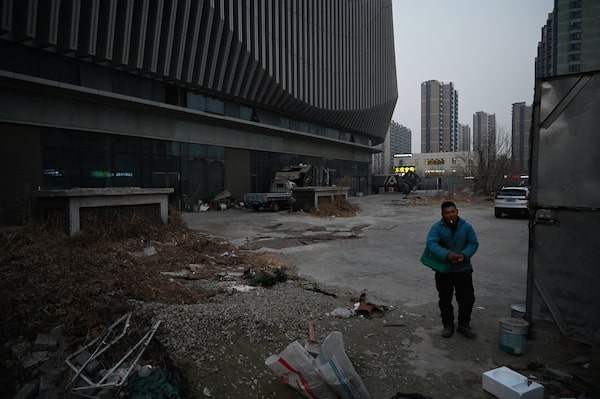
A worker stands outside an abandoned Evergrande commercial complex in Beijing on January 29, 2024.GREG BAKER/Getty Images
John Rapley is an author and academic who divides his time among London, Johannesburg and Ottawa. His books include Why Empires Fall (Yale University Press, 2023) and Twilight of the Money Gods (Simon and Schuster, 2017).
It’s not just Canada that has a housing problem. This week, China’s Evergrande Group, the country’s second-largest property developer, was ordered into liquidation by a Hong Kong court. It’s a symptom of a malaise in the country – namely, an economic model that has reached its limits.
The World Bank expects the Chinese economy to grow by 4 to 5 per cent this year, just shy of Beijing’s official target of 5 per cent. That may sound like a lot but it’s well below the country’s boom years, when annual growth reached double digits. Moreover, even that 4.5-per-cent figure should be treated with a pinch of salt. Chinese data isn’t always reliable, and some experts estimate the economy may actually be growing at something closer to 3 per cent.
Even that might seem pretty good were it not that China lags the Western economies by some distance. Despite four decades of spectacular growth, the country’s per capita income is still only about a fifth that of the United States. If its best years are behind it, its geopolitical competition with the United States will be over.
That’s more than Beijing can stomach. When China first began allowing capitalism to re-enter the country back in the late 1970s, the ruling party did not do as many Western analysts expected – and as the Soviet Union would later do, to disastrous effect to itself – and liberalize the political system as well. On the contrary, it tightened its hold on political power and crushed the fledgling democratic movement after it assembled in Tiananmen Square.
An unspoken social contract then governed relations between the ruling Communist Party and its citizens: you forego freedom, we’ll give you prosperity. The growth model it used to develop its economy was straightforward: move China’s immense population from the countryside to the cities, where it would provide a budding industrial sector with endless quantities of cheap labour.
Given that Western countries were then trying to revive their own economies, the reopening of China to the world provided what seemed like a golden opportunity. On the one hand, by allowing their firms to outsource production to China, they could boost their profits and thus trigger a new wave of investment back home. Equally, by importing the goods made by cheap Chinese labour, they could bring down inflation and interest rates, which would not only benefit Western middle classes but also further support investment. So over the two decades straddling the turn of the millennium, China became the workshop of the world, producing a third of the planet’s manufactured goods.
But in the wake of the 2008 financial crisis, something changed. First off, China started running out of labour. As its population aged, wages started rising, making China a less attractive outsourcing destination. More significantly, the world began to lose some of its appetite for Chinese imports. Western governments began to face pushback from their voters, who felt they were losing jobs to China. Although Donald Trump’s trade war didn’t restore American jobs, the turn against China had begun.
The pandemic added further impetus to this reorientation. When the closure of shipping routes during the lockdowns revealed just how dependent Western countries had become on a wide range of Chinese imports, policy-makers began talking of decoupling or de-risking their economies, thereby reducing their exposure to the Middle Kingdom. The world continued importing vast amounts of stuff from China. But it became clear that the future trajectory of Western demand for Chinese imports would grow more slowly than in the past. The resulting slowdown in the country’s economy has left its leaders with a dilemma.
Given China’s huge domestic market, and the fact that the country spends only about half its annual output, putting the rest into savings accounts or towards investment, the Chinese government could start to sell more of what the country produces at home. In theory, reducing investment and then boosting demand would suffice to restore China’s growth rates of old. But that would require some easing of controls on civil society since more investment and spending decisions would be delegated to citizens rather than bureaucrats and oligarchs.
Under Xi Jinping, the trend has gone the opposite way. His ‘Common Prosperity’ program has been clamping down on what the ruling party considers the excesses of oligarchs. Instead, to jolt the economy back to life, the government has resorted to what it does best – engineering massive investment, overseas to widen its markets via its Belt and Road Initiative; at home with construction booms in property and infrastructure, most notably high-speed rail.
The problem is that when you inflate supply and not demand, deflation results. A lot of those homes or office buildings go unsold. Prices fall. Owners become insolvent. And so here we are. This dilemma won’t solve itself. Until China’s leaders confront it head-on and alter their model towards a more demand-focused one, the economy is likely to keep slowing.